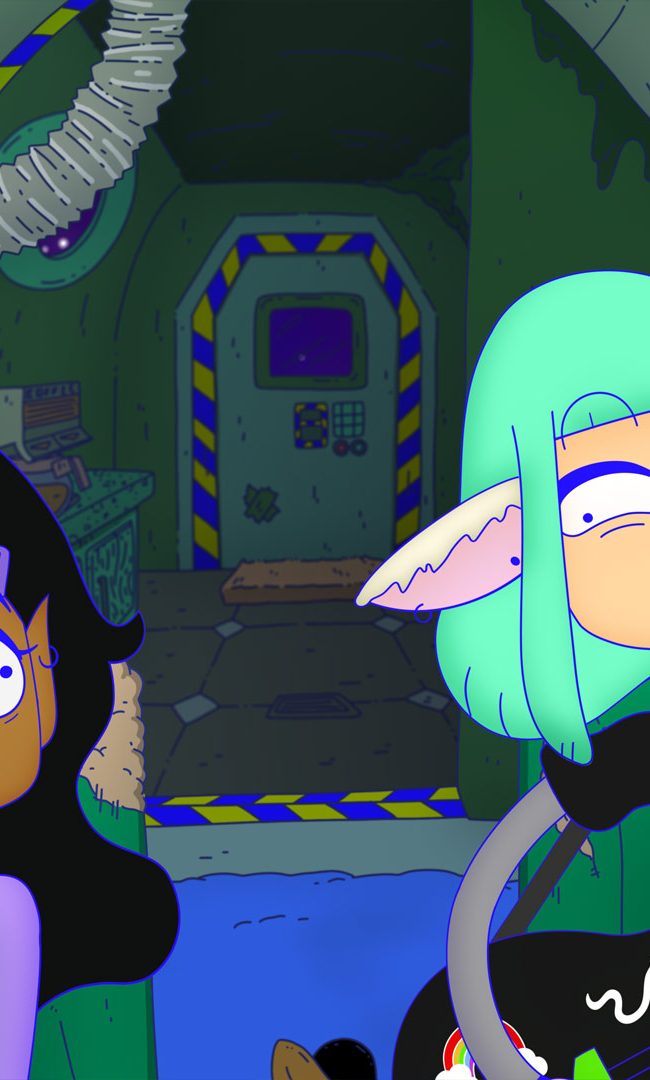STRANGE JOURNEY: THE STORY OF ROCKY HORROR

(Check out Jessica Baxter’s Strange Journey: The Story of Rocky Horror movie review, it’s in select theaters now! Seen it? Join the conversation with HtN on our Letterboxd Page.)
If you’re reading this review, chances are you’re already aware of the awesome power of movies. The best films can be the connective tissue for society’s outcasts. Even those with more “normie” proclivities can unlock something hidden deep within them when exposed to the right combination of moving images, sounds, and vibes.
For many people, that first magic film was and IS The Rocky Horror Picture Show. So-called Transylvanians don’t forget the first time they saw Frank-N-Furter throw off his cape to strut around in a saucy corset without apology. At the Frankenstein place, It’s Brad and Janet, in their J.C. Penny undergarments, who are the outsiders. But even they will be welcomed into the fold with open arms (and legs).
Linus O’Brien’s film, Strange Journey: The Story of Rocky Horror, is so much more than a historical document. It’s an origin story for a cultural touchstone of Queerdos. And yes, you can be straight and still be counted among their ranks, so long as you leave your judgments outside in the rain. Richard O’Brien first birthed his masterwork in the form of a 1973 London stage show, with Tim Curry in the original cast. It was wildly popular, but it would take fits and starts to grow into the juggernaut it is today. Fifty years later, it resonates anew with young audiences and slips on like an old fishnet stocking for O.G. fans.
Who better to tell this storied history than a guy who literally grew up with Rocky Horror: Linus O’Brien. Richard O’Brien’s son was always aware that his dad wrote a pervasive musical, but it didn’t dawn on him until a few years ago, just how meaningful it is to people. He explains it beautifully in his director’s statement:
“As I read through the comments [on a youtube video of “I’m Going Home”], I was overcome with emotion – each person shared their personal story and the deep place the song held in their heart… this was the first time I truly grasped the enormity of its influence on individual lives… the unique cult phenomenon it fostered and the safe space it created for all kinds of people; and the unfortunate reality that, in today’s political climate, Rocky is as relevant as ever.”
When you make a Rocky Horror reference, and someone else picks up on it, you’re instantly bonded in an ineffable way. Linus’ mission was to imbue his film with the emotions and sentiments that people shared on youtube and in every other space where fans gather.
I would say, he accomplished his mission. Linus had access to everyone you’d want to hear from, including Richard O’Brien, Little Nell, Patricia Quinn, Peter Hinwood, Susan Sarandon, Barry Bostwick, Lou Adler, and of course, Tim Curry, who discusses the role with such reverence and seriousness, you’d think he was recounting playing Lear at the Royal Shakespeare Company.
Drag queen Trixie Mattel and singer/actor Jack Black also cite Rocky Horror as a pivotal influence in their entertainment careers. Trixie learned to weaponize her queerness, adopting the derogatory nickname spewed at her by bullies, as her powerful stage persona. Black says that when he saw Meat Loaf busting through the wall, sweeping a girl off her feet, and blowing the roof off with his voice, he knew that even a chubby little guy could be a rock star. There’s seemingly no limit to the types of people who could see themselves reflected in this weird, gay, sci-fi musical.
When The Rocky Horror Picture Show was theatrically released in 1975, it was an absolute flop by box office standards. But it wasn’t meant to be Titanic. It needed time to find its audience, burrow under their skin, and spread by word of mouth. To this day, odds are you can find a theater within driving distance that still shows this film at least once a month. That’s because it’s more than a film. It’s a secular, queerdo church service. It stood as a means of expression for kids who sometimes feared for their very lives in any other context. As Trixie put it: “It was very gay, but I was very much allowed to like it”.
Strange Journey is also very inspiring from an independent filmmaking perspective. Thanks to the work of producer, Lou Adler, they were basically left alone to make the exact film they wanted to make, starring most of the original cast, with the original director at the helm. They had a low budget, but they were being paid to make their vision come to life. It’s very exciting to hear how they pulled it off this cinematic miracle.
We also hear from people who have been in the Shadow Cast over the years – mostly amateur actors who dress up and act out the film on stage while the film plays behind them. They discuss how this phenomenon sprang into being, and how it morphed and grew over the years. They also investigate the evolution of the “call backs” – specific phrases that audiences know to shout at certain times during the film. Somehow, the call backs spread around the globe BEFORE people had access to the internet. When you see the red-yarned map laid out by Linus O’Brien, the cultural journey and impact of The Rocky Horror Picture Show is truly astonishing.
Legacy aside, Linus takes some time to ask his dad the hard questions about his inspiration for creating Frank-N-Furter. His answers aren’t particularly surprising, but it’s no-less heartbreaking to hear from the man himself. Even someone as unabashed as Richard O’Brien still felt he had to generate an avatar to express his deepest desires. It’s not like society has done much to prove him wrong over the years, either. But he seems to have made peace with his identity and cut the apron strings from his creation. Richard O’Brien says the fans have told him loud and clear, “It doesn’t matter what it means to you because it’s not yours anymore. It belongs to us now.” Indeed, the best art is collective art. Otherwise, you’re just jerking off alone.
– Jessica Baxter (@TheBaxter)











